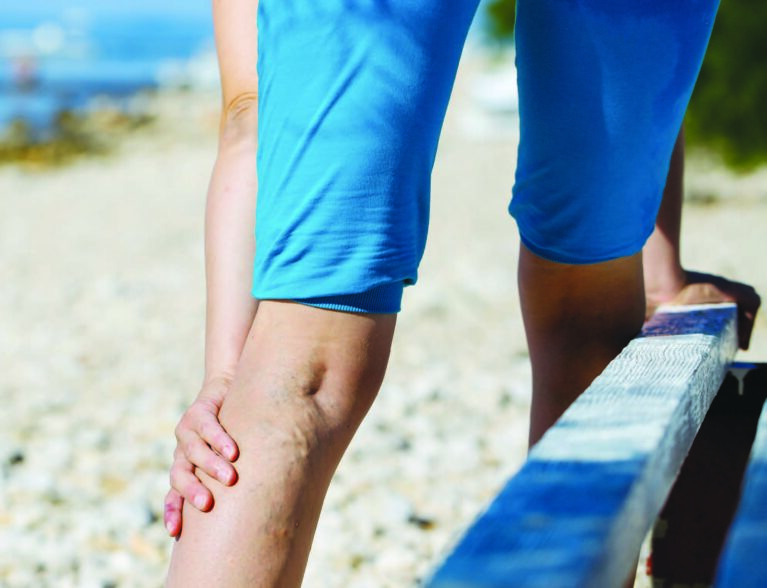
Varicose veins are a common condition, affecting approximately 35 percent of the U.S. population at some point in their lives, and they typically are thought of as a mainly cosmetic problem.
But there also are medical grade varicose veins, says Irfan Riaz Imami, MD, a board-certified vascular surgeon and general surgeon at Health First’s Holmes Regional Medical Center.
“Many people develop spider veins when they’re still in their 20s,” he explains. “Although they can become larger, that’s not always the case. For the most part, spider veins are a cosmetic concern.”
According to WebMD, spider veins are smaller than varicose veins and don’t bulge out. Although both varicose and spider veins are damaged blood vessels, spider veins are not actually veins – they are capillaries or other smaller blood vessels. Spider veins rarely cause pain or other symptoms beyond their appearance.
Dr. Imami says that if spider veins do develop into a more severe case, it often takes decades.
Varicose veins that may need medical treatment are bulging, sometimes bluish veins that look like tangled cords running just beneath the surface of your skin. They usually affect the legs, ankles and feet.
Symptoms can include an aching or heavy feeling in the legs; burning, throbbing, muscle cramping and swelling in the lower legs; worse pain after sitting or standing for a long time; itching around one or more of the veins; and changes in skin color around a varicose vein.
What are the odds you’ll develop varicose veins?
“If a close family member suffered from them, there’s a 60-to-70-percent chance you will, too,” says Dr. Imami. “Do you have a job where you’re on your feet all day? Live a sedentary life? Have a history of blood clots? Are you overweight? Have you had multiple pregnancies? All those factors increase the chances you will, at some point, have varicose veins.”
Johns Hopkins Medicine adds older age, being female, smoking and taking oral contraceptive pills or hormone replacement to that list.
Chronic venous insufficiency (CVI) is another causative factor for varicose veins.
“Veins carry blood to the heart,” explains Dr. Imami. “CVI happens when your leg veins go bad and can’t work as they should.
“Normally, valves in your leg veins keep blood flowing back up to your heart. But CVI damages those valves, causing blood to pool in your legs. This increases pressure in your leg veins and causes symptoms like swelling and ulcers.
“Chronic venous insufficiency brings its own set of problems,” Dr. Imami says. “Too much salt in your diet can lead to fluid retention and your kidneys don’t pee out as much as they did in your younger years. It can also lead to heart failure and lymphedema.”
Cleveland Clinic advises that varicose veins affect about 1 in 3 adults and of those, each year, about 1 in 50 adults with varicose veins go on to develop chronic venous insufficiency.
Mayo Clinic suggests seeing your doctor if you are unhappy with the appearance of your legs or varicose vein symptoms become acutely uncomfortable and do not respond to self-care.
You should also seek medical assistance if the skin over your varicose veins becomes flaky, ulcerated, discolored or prone to bleeding; if you have red, warm and tender varicose veins; or if you have injured a varicose vein. If the symptoms of your varicose veins worsen suddenly or you notice bleeding or a sore, you should call your doctor right away.
“Your doctor will do a vascular ultrasound to check the condition of your valves. He or she will determine the severity of the problem. Chances are it will be suggested that you wear compression hose for three months.
“If there’s no improvement, it may be recommended that you have an ablation, a minimally invasive procedure that treats varicose veins by closing off the diseased vein with heat or chemicals.
“It’s a walk-in, walk-out procedure done under local anesthesia that has a very slight chance of any problems.”
Although the genetics that cause varicose veins are unavoidable, Mayo Clinic offers some suggestions on how to prevent them otherwise:
- Don’t wear high heels or tight stockings, other than compression stockings.
- Change how you sit or stand often.
- Eat a high-fiber, low-salt diet.
- Exercise.
- Raise your legs when sitting or lying down.
- Keep a healthy weight.
Dr. Imami says venous disease can only be controlled, not cured, but relief from symptoms is possible. “Even if you have procedures or treatments today, they may have to be repeated in ten years as the body creates more pathways.”
Irfan Riaz Imami, MD, is a board-certified vascular surgeon and general surgeon at Health First Wound & Hyperbaric Center. He has a subspecialty board in venous and lymphatic disease. He served his vascular surgery fellowship at Henry Ford Hospital and did his general surgery residency at University of Florida. He earned his Doctor of Medicine from Finch University of Health Sciences/Chicago Medical School and his Bachelor of Science from Emory University. He also has an MBA in health policy from the University of Miami. His office is located at Health First Medical Group, 1223 Gateway Drive, Suite 2C, Melbourne. The phone number is 321-549-0815.



